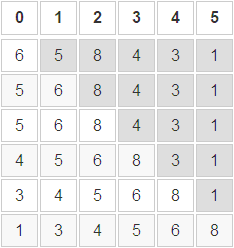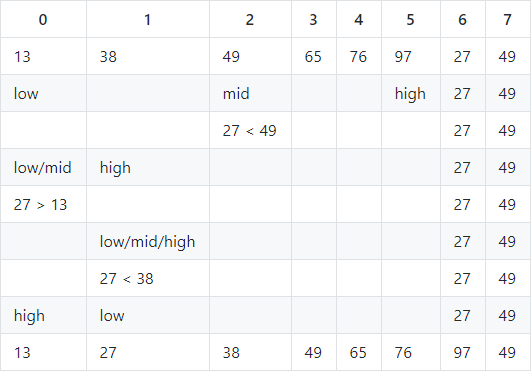直接插入排序
- 在有序数组中插入一个元素,可以作为一种排序方法的基础
- 只有一个元素的数组是一个有序数组,对n个元素的数组,可以从第一个元素所构成的单元数组开始,不断实施插入操作
- 插入第二个元素,得到2个元素的有序数组。插入第三个元素,得到3个元素的有序数组
- 如此反复,得到n个元素的有序数组
示例
对序列:6,5,8,4,3,1 进行直接插入排序

- 图中灰色部分代表待排序列
- 图中透明部分代表已排序列
// C++ program for insertion sort #include <bits/stdc++.h> using namespace std; /* Function to sort an array using insertion sort*/ void insertionSort(int arr[], int n) { int i, key, j; for (i = 1; i < n; i++) { key = arr[i]; j = i - 1; /* Move elements of arr[0..i-1], that are greater than key, to one position ahead of their current position */ while (j >= 0 && arr[j] > key) { arr[j + 1] = arr[j]; j = j - 1; } arr[j + 1] = key; } } // A utility function to print an array of size n void printArray(int arr[], int n) { int i; for (i = 0; i < n; i++) cout << arr[i] << " "; cout << endl; } /* Driver code */ int main() { int arr[] = { 12, 11, 13, 5, 6 }; int n = sizeof(arr) / sizeof(arr[0]); insertionSort(arr, n); printArray(arr, n); return 0; } // This is code is contributed by rathbhupendra
记法:
- 开辟一个临时变量,记录无序序列第一个元素
- 与有序序列的元素比较大小,从后往前
- 如果临时变量小于当前比较元素,当前比较元素后移一位
- 否则,临时变量占用当前比较位
时间复杂度分析
由直接插入排序代码,选取最内层
a[j + 1] = a[j];
作为基本操作语句
- 考虑最坏的情况,即整个序列是逆序的,O(n^2)
- 考虑最好的情况,即整个序列是有序的,O(n)
综上所述,本算法的平均时间复杂度O(n^2)
空间复杂度分析
- 算法所需的辅助存储空间不随待排序列规模的变化而变化,是个常量,O(1)
折半插入排序
- 与直接插入排序思想类似,区别是查找插入位置的方法不同,折半插入排序是采用折半查找法查找插入位置的
- 将待排序的记录R[i],通过折半查找的方式在有序序列中查找插入位置
示例
对序列:13,38,49,65,76,97,27,49进行一趟折半插入排序。
前6个元素已经排好序列,查找27的插入位置
- mid = (0 + 5)/2 = 2,当前位置,27 < 49,27的插入位置在49的低半区
- h = mid - 1,mid = (0 + 1)/2 = 0,当前位置,27 > 13,27插入位置在13的高半区
- low = mid + 1,mid = (1 + 1)/2 = 1,27 < 38,27的插入位置在38低半区
- high = m - 1 = 0,high < low,折半查找结束,27的插入位置在high之后,插入位置后面的元素后移

// C program for implementation of binary insertion sort
#include <stdio.h>
// A binary search based function to find the position
// where item should be inserted in a[low..high]
int binarySearch(int a[], int item, int low, int high)
{
if (high <= low)
return (item > a[low])? (low + 1): low;
int mid = (low + high)/2;
if(item == a[mid])
return mid+1;
if(item > a[mid])
return binarySearch(a, item, mid+1, high);
return binarySearch(a, item, low, mid-1);
}
// Function to sort an array a[] of size 'n'
void insertionSort(int a[], int n)
{
int i, loc, j, k, selected;
for (i = 1; i < n; ++i)
{
j = i - 1;
selected = a[i];
// find location where selected sould be inseretd
loc = binarySearch(a, selected, 0, j);
// Move all elements after location to create space
while (j >= loc)
{
a[j+1] = a[j];
j--;
}
a[j+1] = selected;
}
}
// Driver program to test above function
int main()
{
int a[] = {37, 23, 0, 17, 12, 72, 31,
46, 100, 88, 54};
int n = sizeof(a)/sizeof(a[0]), i;
insertionSort(a, n);
printf("Sorted array:
");
for (i = 0; i < n; i++)
printf("%d ",a[i]);
return 0;
}
记法
- 开一个遍历,开辟一个临时变量,记录每次遍历的第一个的元素
- 临时变量与有序序列中间元素比较,小于则去底半区查找,大于则去高半区查找
- 若找到相同元素,则记录当前位置的后移一位
- 若找不到相同元素,小于low记录low的位置,大于low记录low的位置+1
- 最后交换相应位置(后移并插入的一个过程)
时间复杂度分析
- 折半插入排序适合关键字数较多的场景,与直接插入排序相比,折半插入排序在查找插入位置上面所花的时间大大减少
- 折半插入排序在关键字移动次数上面和直接插入排序是一样的,所以时间复杂度和直接插入排序还是一样的
- 可知折半插入排序的时间复杂度最好情况为O(nlog2n),最差情况为O(n^2),平均情况为O(n^2)
空间复杂度分析
同直接插入排序,O(1)
希尔排序(缩小增量排序)
-
将待排序列分成几个子序列,分别对这几个子序列进行直接插入排序
-
如果增量是1,那么就是直接插入排序
该方法实质上是一种分组插入方法
- 比较相隔较远距离(称为增量)的数,使得数移动时能跨过多个元素,则进行一次比较就可能消除多个元素交换
算法思想
-
先将要排序的一组数按某个增量d分成若干组,每组中记录的下标相差d
-
对每组中全部元素进行排序,然后再用一个较小的增量对它进行,在每组中再进行排序
-
当增量减到1时,整个要排序的数被分成一组,排序完成
示例
- 原始序列:49 38 65 97 76 13 27 45 55 04

- 分割线指向的元素做直接插入排序
// C++ implementation of Shell Sort
#include <iostream>
using namespace std;
/* function to sort arr using shellSort */
int shellSort(int arr[], int n)
{
// Start with a big gap, then reduce the gap
for (int gap = n/2; gap > 0; gap /= 2)
{
// Do a gapped insertion sort for this gap size.
// The first gap elements a[0..gap-1] are already in gapped order
// keep adding one more element until the entire array is
// gap sorted
for (int i = gap; i < n; i += 1)
{
// add a[i] to the elements that have been gap sorted
// save a[i] in temp and make a hole at position i
int temp = arr[i];
// shift earlier gap-sorted elements up until the correct
// location for a[i] is found
int j;
for (j = i; j >= gap && arr[j - gap] > temp; j -= gap)
arr[j] = arr[j - gap];
// put temp (the original a[i]) in its correct location
arr[j] = temp;
}
}
return 0;
}
void printArray(int arr[], int n)
{
for (int i=0; i<n; i++)
cout << arr[i] << " ";
}
int main()
{
int arr[] = {12, 34, 54, 2, 3}, i;
int n = sizeof(arr)/sizeof(arr[0]);
cout << "Array before sorting: ";
printArray(arr, n);
shellSort(arr, n);
cout << " Array after sorting: ";
printArray(arr, n);
return 0;
}
#include <iostream>
using namespace std;
/* function to sort arr using shellSort */
int shellSort(int arr[], int n)
{
// Start with a big gap, then reduce the gap
for (int gap = n/2; gap > 0; gap /= 2)
{
// Do a gapped insertion sort for this gap size.
// The first gap elements a[0..gap-1] are already in gapped order
// keep adding one more element until the entire array is
// gap sorted
for (int i = gap; i < n; i += 1)
{
// add a[i] to the elements that have been gap sorted
// save a[i] in temp and make a hole at position i
int temp = arr[i];
// shift earlier gap-sorted elements up until the correct
// location for a[i] is found
int j;
for (j = i; j >= gap && arr[j - gap] > temp; j -= gap)
arr[j] = arr[j - gap];
// put temp (the original a[i]) in its correct location
arr[j] = temp;
}
}
return 0;
}
void printArray(int arr[], int n)
{
for (int i=0; i<n; i++)
cout << arr[i] << " ";
}
int main()
{
int arr[] = {12, 34, 54, 2, 3}, i;
int n = sizeof(arr)/sizeof(arr[0]);
cout << "Array before sorting: ";
printArray(arr, n);
shellSort(arr, n);
cout << " Array after sorting: ";
printArray(arr, n);
return 0;
}
希尔排序不稳定
-
增量序列的最后一个值一定取1
-
增量序列中的值尽量没有除1之外的公因子
时间复杂度
- 时间与步长选取有关,但目前没有对应解析表达式